
Oceanic (unfinished ship)
Encyclopedia

Ocean liner
An ocean liner is a ship designed to transport people from one seaport to another along regular long-distance maritime routes according to a schedule. Liners may also carry cargo or mail, and may sometimes be used for other purposes .Cargo vessels running to a schedule are sometimes referred to as...
that was partially built by Harland and Wolff
Harland and Wolff
Harland and Wolff Heavy Industries is a Northern Irish heavy industrial company, specialising in shipbuilding and offshore construction, located in Belfast, Northern Ireland....
for the White Star Line
White Star Line
The Oceanic Steam Navigation Company or White Star Line of Boston Packets, more commonly known as the White Star Line, was a prominent British shipping company, today most famous for its ill-fated vessel, the RMS Titanic, and the World War I loss of Titanics sister ship Britannic...
. The ship was to have been the first 1000 feet (304.8 m)-long ocean liner.
The order was placed 18 June 1928, and construction began almost immediately. The work was slowed by a dispute over powerplant; Lord Kylsant who controlled the White Star Line wanted to use diesel-electric
Diesel-electric
Diesel-electric transmission or diesel-electric powertrain is used by a number of vehicle and ship types for providing locomotion.A diesel-electric transmission system includes a diesel engine connected to an electrical generator, creating electricity that powers electric traction motors...
instead of the traditional steam
Steamboat
A steamboat or steamship, sometimes called a steamer, is a ship in which the primary method of propulsion is steam power, typically driving propellers or paddlewheels...
power. White Star proposed having over 40 diesel generator
Diesel generator
A diesel generator is the combination of a diesel engine with an electrical generator to generate electrical energy....
sets driving four propellers through geared electric motors. Harland & Wolff was reluctant to adopt this system and by the time all parties had settled on the use of diesel, the Great Depression
Great Depression
The Great Depression was a severe worldwide economic depression in the decade preceding World War II. The timing of the Great Depression varied across nations, but in most countries it started in about 1929 and lasted until the late 1930s or early 1940s...
was underway and hitting the shipping business.
Further work on the Oceanic was postponed, and later cancelled due to the collapse of the Royal Mail Steam Packet Company
Royal Mail Steam Packet Company
The Royal Mail Steam Packet Company was a British shipping company founded in London in 1839 by Scot James Macqueen. After good and bad times it became the largest shipping group in the world in 1927 when it took over the White Star Line....
, owners of the White Star Line, as a result of the financial problems of Sir Owen Philips, Lord Kylsant
Owen Philipps, 1st Baron Kylsant
Owen Cosby Philipps, 1st Baron Kylsant was a British businessman and politician, later jailed for producing a document with intent to deceive.-Background:...
. The Royal Mail Case
Royal Mail Case
The Royal Mail Case or R v Kylsant & Otrs was a noted English criminal case in 1931. The director of the Royal Mail Steam Packet Company, Lord Kylsant, had falsified a trading prospectus with the aid of the company accountant to make it look as if the company was profitable and to entice potential...
, as it was known, led to the imprisonment and loss of title of Owen Philips, also substantial changes in accounting and auditing practice. Loans backed by the governments of England and Northern Ireland intended for the construction of the Oceanic were diverted to the construction of the last two ships built for White Star, the RMS Britannic
RMS Britannic (1929)
RMS Britannic was an ocean liner of the White Star Line, the company's third ship to bear the name. She was built by Harland & Wolff in Belfast. She was launched on 6 August 1929. Like her running mate , Britannic was a motorship powered by diesel engines. She measured 26,943 gross tons and was ...
and her near twin sister, the RMS Georgic
RMS Georgic (1932)
Built at Harland and Wolff shipyard in Belfast, the RMS Georgic was the last ship built for the White Star Line before its merger with the Cunard Line. She was the running mate of the Britannic. Like Britannic, Georgic was a motorship, and not a steamer, fitted with a diesel electric powerplant.-...
. These two liners were built with steel from Oceanic, whose partially-built hull was subsequently dismantled and recycled after the aforementioned diversion of funds.
Based on original plans, the ship would have measured 60,000 tons and have three funnels, making her appear like a larger version of the MV Britannic with her flatter front superstructure than the Georgic which is curved. Some maritime experts believe that she would have been completed as a ship of about 80,000 tons, roughly the size of her rivals and , along with powerful engines which would have enabled the ship to possibly gain the Blue Riband
Blue Riband
The Blue Riband is an unofficial accolade given to the passenger liner crossing the Atlantic Ocean in regular service with the record highest speed. The term was borrowed from horse racing and was not widely used until after 1910. Under the unwritten rules, the record is based on average speed...
record for speed.

